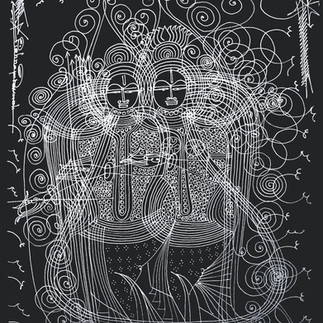Ananta Kathā: Legacy of Surpur Miniature Painting
- Artlune
- 5 days ago
- 3 min read
Ever heard of Surpur miniature paintings?
When you pause to admire the works of Krishna Prakash Vasant, you’re not just seeing contemporary art; you’re stepping into a story that began centuries ago. Behind each intricate line lies a forgotten chapter of South Indian history. This art form blends faith, power, and beauty, and through Krishna’s work, this old language of art finds a fresh, modern voice.

Tracing the Roots of Surpur Miniature Paintings
The story of Surpur painting takes us back to 1565, right after the Battle of Talikota, which led to the fall of the Vijayanagara Empire. When the empire collapsed, its artists set out on new journeys, carrying their craft and vision to places like Surpur (now in Karnataka) and Rajahmundry (in Andhra Pradesh).
Later, under Raja Venkatappa Nayak IV (between 1773 and 1858), Surpur painting saw its golden age. Artists began to look beyond temple walls and religious scenes, creating portraits, royal stories, and everyday moments that reflected both devotion and royal pride. What started as sacred art grew into a way of expressing identity, power, and belief, a spirit that continues to live on in Ananta Kathā and Krishna Prakash Vasant’s reimagining of this timeless tradition.
Majesty in Detail: A Visual Language of Grace and Spirit
The Surpur miniature painting tradition shares similarities with Mysore and Tanjore paintings, especially in its use of gesso, vibrant colours, and embellishments like gold leaf and semi-precious stones. These materials gave the works a distinct radiance and sense of grandeur.
Early Surpur paintings were created mainly for ritual purposes, often seen on temple walls or large cloth panels. With royal patronage, artists later began working on wood and paper, continuing to use gold leaf and other rare materials that reflected their artistic value.
What makes this tradition truly captivating is its delicate line work, flowing brushstrokes, elongated eyes, and intricate ornaments that give the figures elegance and quiet dignity. The use of profile compositions adds to their grace, while the colour choices, guided by the Rasa theory in Indian aesthetics, bring depth to each piece. For instance, deep blue tones often symbolise the divine nature of Vishnu, blending devotion and beauty in perfect harmony.
Ananta Kathā: Where Traditions Meet the Contemporary
In Krishna Prakash Vasant’s series The World Public Relationship Connection, the spirit of Surpur miniature painting comes alive in a modern form. Working with monochromatic ink on paper, Krishna carries forward the precision of miniature art through his long, fluid lines.
With monochromatic tones and subtle touches of gold, he bridges the classical and the contemporary. Now presented by Artlune as his first solo virtual exhibition, Ananta Kathā: Roots & Renewal. It celebrates this meeting of tradition and innovation, a journey of both return and rediscovery.
As we look at the works, we can almost feel the pulse of time, a rhythm that flows from the royal courts of Surpur to the hands of a contemporary artist, connecting centuries through the enduring language of art.
Bibliography:
Ma, Kuei-yuan. “味情表演:宗教意涵的崇高與身體——以Rasa、Bhava、Abhinaya理論為中心.” 戲劇學刊 1 (January 2005): 91–120. Taiwan Journal Article Index System.
“Surpur Painting.” MAP Academy. Accessed October 22, 2025. https://mapacademy.io/article/surpur-painting/.
“South Indian Gold Leaf Paintings.” Victoria and Albert Museum Blog. Accessed October 22, 2025. https://www.vam.ac.uk/blog/museum-life/south-indian-gold-leaf-paintings.
“Ananta Kathā: Roots & Renewal.” Artlune. Accessed October 22, 2025. https://www.artlune.com/projects/ananta-katha-roots-renewal .






